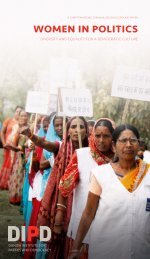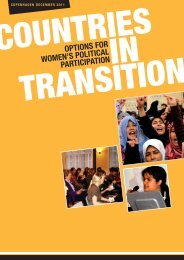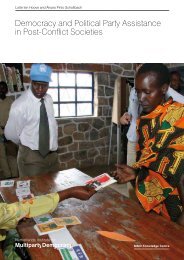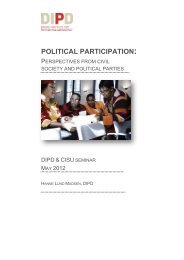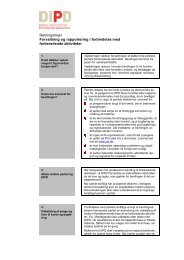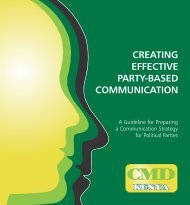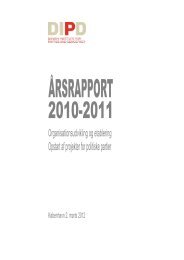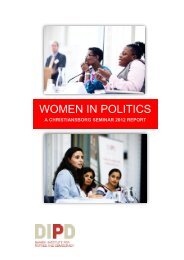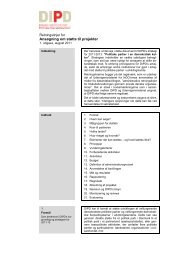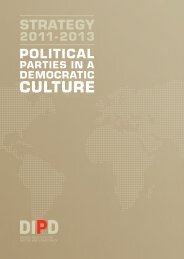Political Parties in Africa: Challenges for Sustained Multiparty
Political Parties in Africa: Challenges for Sustained Multiparty
Political Parties in Africa: Challenges for Sustained Multiparty
Create successful ePaper yourself
Turn your PDF publications into a flip-book with our unique Google optimized e-Paper software.
<strong>Political</strong> <strong>Parties</strong> <strong>in</strong> <strong>Africa</strong>: <strong>Challenges</strong> <strong>for</strong> Susta<strong>in</strong>ed <strong>Multiparty</strong> Democracy<br />
The study consisted of three questionnaires. The first was about the socio-political<br />
and economic environment <strong>in</strong> which the parties function and about how free or<br />
restricted the parties are <strong>in</strong> carry<strong>in</strong>g out their political and electoral activities <strong>in</strong><br />
the respective countries. The second questionnaire dealt with the legal provisions<br />
that regulate parties. These <strong>in</strong>clude the found<strong>in</strong>g of parties, their registration and<br />
<strong>in</strong>ternal function<strong>in</strong>g, the rules and regulations <strong>for</strong> contest<strong>in</strong>g elections, the conduct<br />
of election campaigns and the agencies that monitor the conduct of parties. This<br />
was done ma<strong>in</strong>ly by desk research. Sources of <strong>in</strong><strong>for</strong>mation on the country context<br />
and external regulations <strong>in</strong>cluded constitutions, legislative acts and orders passed<br />
by the executive branch; rules, regulations, codes and orders of the election<br />
commissions; and judgements of the highest courts <strong>in</strong> the respective countries.<br />
Official statistical reports, reports of the United Nations Educational, Scientific and<br />
Cultural Organization (UNESCO), the Freedom House Index, the United Nations<br />
Development Programme (UNDP) Human Development Report, and Transparency<br />
International’s Corruption Perceptions Index, among other sources, were used <strong>for</strong><br />
relevant <strong>in</strong><strong>for</strong>mation.<br />
The third questionnaire constituted an <strong>in</strong>-depth analysis of the organizational<br />
structures of the parties and the way <strong>in</strong> which the parties actually function. In<strong>for</strong>mation<br />
was collected through face-to-face <strong>in</strong>terviews with the leaders of various parties. In<br />
most cases, five leaders and party officials from each party were <strong>in</strong>terviewed. Each<br />
<strong>in</strong>terview took at least one hour and some required longer. Sometimes it required more<br />
than one sitt<strong>in</strong>g with a leader or official. In choos<strong>in</strong>g the representatives <strong>for</strong> parties<br />
<strong>for</strong> the <strong>in</strong>terviews, care was taken to <strong>in</strong>terview at least one of the top party leaders, a<br />
people’s representative <strong>in</strong> legislative bodies, preferably at the national level, a woman<br />
leader and a youth leader. Wherever the treasurer of a party was available, he or she<br />
was <strong>in</strong>terviewed. Thus, the account of the <strong>in</strong>ternal function<strong>in</strong>g of parties is based<br />
primarily on the <strong>in</strong><strong>for</strong>mation and responses of the party leaders. What is attempted<br />
is to develop a self-portrait of parties as presented by party leaders themselves.<br />
Be<strong>for</strong>e the <strong>in</strong>terviews with <strong>in</strong>dividual leaders were conducted, the parties were<br />
<strong>in</strong><strong>for</strong>med about the research project and provided with an overview of the research.<br />
The meet<strong>in</strong>gs with leaders were arranged by prior appo<strong>in</strong>tment. Most of the party<br />
leaders were cooperative and will<strong>in</strong>g to spare time. Busy as they were with other<br />
press<strong>in</strong>g matters, some were not able to spend sufficient time to discuss the questions<br />
<strong>in</strong> depth, and some found that the questionnaire was tak<strong>in</strong>g more time than they<br />
were will<strong>in</strong>g to give (two or three <strong>in</strong>terview sessions were required <strong>for</strong> some leaders).<br />
Some were reticent and unwill<strong>in</strong>g to respond <strong>in</strong> detail to some questions with which<br />
they felt uncom<strong>for</strong>table, such as those concern<strong>in</strong>g the election of leaders with<strong>in</strong> the<br />
party, and descriptions of <strong>in</strong>ternal party structures and the selection of candidates.<br />
For some questions, such as those concern<strong>in</strong>g party <strong>in</strong>come, fund<strong>in</strong>g and election



